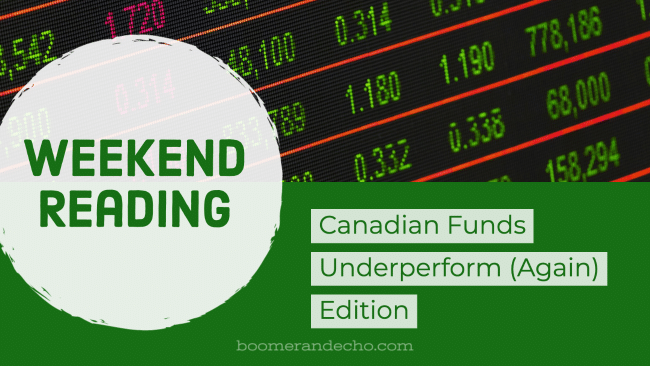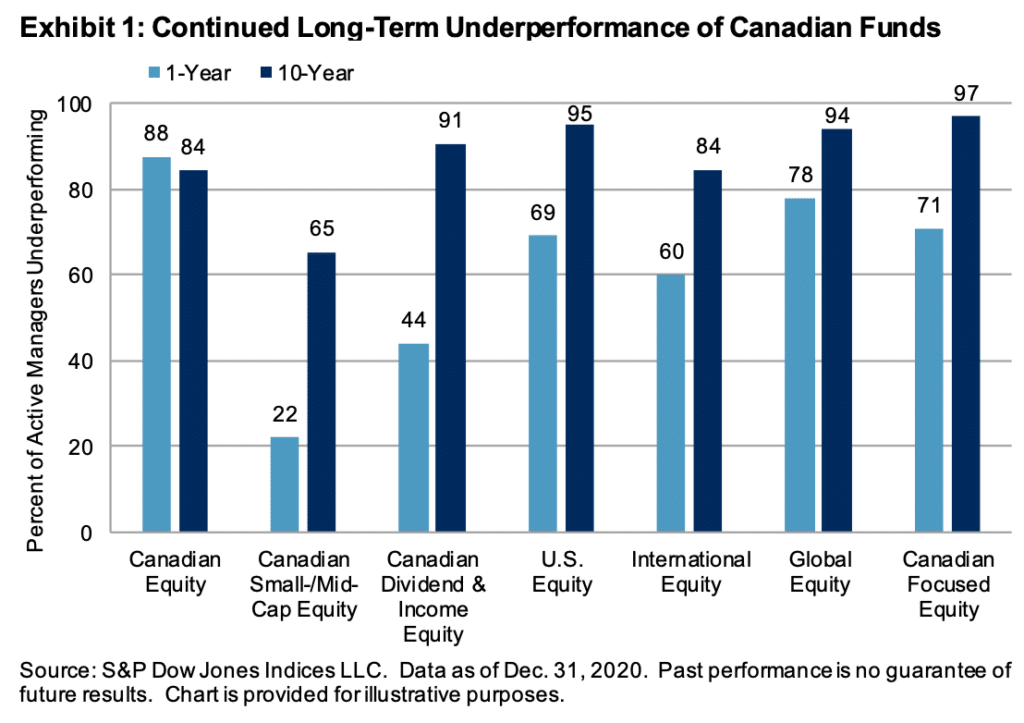Weekend Reading: Canadian Funds Underperform (Again) Edition
Active investors supposedly thrive during periods of market volatility. If that's the case, then 2020 should have been a banner year for active funds.
The year started off strong, with markets hitting all-time highs in February. Then we saw the largest and fastest market decline in history with a 34% sell-off in March. Markets then came roaring back to post positive returns, with the TSX up 5.6% on the year and the S&P 500 up 16.3%.
The promise of active investing is that a skilled fund manager can offer downside protection and outperformance through strategic asset allocation, stock picking, and market timing. How did that turn out in 2020?
The annual SPIVA Scorecard measures the performance of actively managed funds against their relevant benchmark indices.
“Although this volatile period offered ample opportunity for stock-pickers to shine, 88% of Canadian Equity funds underperformed their benchmark in 2020, in line with the 84% that did so over the past 10 years.”
Canadian equity funds in particular had a tough year, underperforming the TSX on average by 4.8%.
Canadian equity funds can largely be described as “closet index funds“, meaning their holdings largely represent the broader index (since Canada's market is not very diverse), but they charge high active management fees. That combination is guaranteed to underperform an index fund.
Dividend funds performed much better versus their benchmark, with just 44% trailing the Canadian Dividend Aristocrats Index. But, it was also the only category to post negative returns on the year. Dividend funds lost 1.2% in 2020, while the Index lost 2.3%. The track record for dividend funds over 10 years is awful, with 91% failing to beat the Index.
U.S. equities have offered the best returns over the past decade, including in 2020. However, 69% of U.S. equity funds failed to beat the S&P 500 last year, and an incredible 95% of active U.S. funds have underperformed over a 10-year period – falling short by an average of 4.1%.
Finally, the active fund industry loves to praise yesterday's winners but the SPIVA report accounts for survivorship bias and tells us that 54% of all funds in the eligible universe 10 years ago have since been liquidated or merged.
The SPIVA results are not surprising if you've followed the active versus passive investing debate. It's incredibly hard to beat the market, and even more difficult to do it with any consistency over time.
And it's not just a fee story like many stock pickers want to believe. You need to compare your own investment returns against an appropriate benchmark to determine whether your judgement is adding any value over simple indexing strategy.
As I've said for years, the best and most reliable investing approach is a low cost, globally diversified, and risk appropriate portfolio of index funds or ETFs.
This Week's Recap:
My wife and I were happy to receive our first vaccine doses earlier this week. Thank you science, and thank you healthcare workers!
I'm currently reading The Data Detective: Ten Easy Rules to Make Sense of Statistics, by the incredibly gifted storyteller Tim Harford. It's worth a read.
Mr. Harford also hosts one of my favourite podcasts, Cautionary Tales – telling true stories about mistakes and what we should learn from them.
Check out last week's edition of Weekend Reading where I opened up the money bag to answer your burning questions.
And, from the archives, here's how to trick your lizard brain into saving more money.
Weekend Reading:
Our friends at Credit Card Genius explain how to get a full refund on flights purchased (and cancelled) through Air Canada.
Michael James on Money advocates for a simple investing approach for the majority of investors, but here he explains why his own portfolio is complicated.
Fee-only advisor Natasha Knox explains how spouses with different risk tolerances can align their investments.
Steadyhand's Tom Bradley offers some excellent advice about not letting portfolio creep catch you unprepared:
“If you’re deviating from your plan by tilting heavily in one direction, it should be done knowing that less diversification comes with added risk. And it should be intentional, not the result of market moves and related product promotions.”
Help! I'm afraid to retire even though I can afford to. This Kiplinger article explains why actually retiring may be the hardest part about retirement.
Can you work too long and save too much? Here's why saving too much for retirement can be a mistake.
On Morningstar, here's how retirees should think about inflation in 2021 (and why inflation risk is somewhat overblown for retirees).
Humble Dollar blogger Jonathan Clements explains why he's hanging tough with his stock heavy portfolio.
If everyone should invest in index funds, why does PWL Capital's Ben Felix still have a job? In this must-watch video, Ben defines exactly what good financial advice actually means. Bookmark this and send it to your friends and family:
A Wealth of Common Sense blogger Ben Carlson answers a common reader question about how much you should have saved in your 30s.
The Blunt Bean Counter blog looks at estate planning and how to solve the sibling wealth gap.
Morgan Housel shares a few short stories.
Finally, fee-only planner Jason Heath looks at the tax implications for Canadians who retire abroad.
Enjoy the rest of your weekend, everyone!



Congrats on getting your jab! I got mine last week as well…being over 40 finally a reason to celebrate 🙂
This underperformance of Canadian funds is frustrating and makes me even more likely to get get into diversified ETFs rather than picking these types of funds. I have a lot of rebalancing to do.
Thank you, Credit Card Genius for the easy to process link to Air Canada refunds. I had been wondering how to go about this process. It was such an easy process. I had a voucher which was of no use to me at this time.
Congratulations on the vaccine! You just get so much peace of mind after you get the first one. Though I have heard cases of people still getting the coronavirus even after full vaccination so doesn’t hurt to still be careful afterwards.
Passive investing all the way! Active *can* be good but most active investors are not worth the huge payout they get.